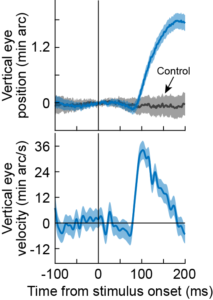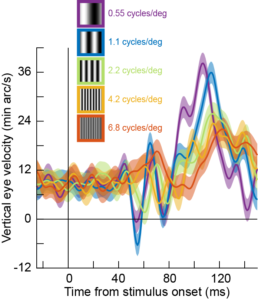 We recently discovered a new fixational eye movement phenomenon, which is now described in a new paper by Tatiana Malevich and Antimo Buonocore. The paper appears in the journal eLife, and it shows how tiny fixational ocular position drifts (about an order of magnitude smaller than microsaccades!) can still be highly systematically stimulus-driven.
We recently discovered a new fixational eye movement phenomenon, which is now described in a new paper by Tatiana Malevich and Antimo Buonocore. The paper appears in the journal eLife, and it shows how tiny fixational ocular position drifts (about an order of magnitude smaller than microsaccades!) can still be highly systematically stimulus-driven.
Specifically, we noticed that under certain visual image conditions, the eye would drift by a tiny amount (on the order of just a couple of minutes of arc) with ultra-short latency after image onset. Despite such small size and fast response latency, the drift response was highly systematic, suggesting an unprecedented level of control by the brain over eye position.
The phenomenon was also binocular, with both eyes drifting at the same time and in the same direction and by the same amount.
Most interestingly, the ocular position drift response exhibited tuning to specific image features, such as whether the pattern that was presented was coarse (low spatial frequency) or fine (high spatial frequency).

We are very excited about these results because they show that the brain is operating highly precisely at the very limits of performance capacity in terms of both latency and spatial precision.
We are now exploring the neurophysiological implications of these surprising findings.
The paper can be read here.

